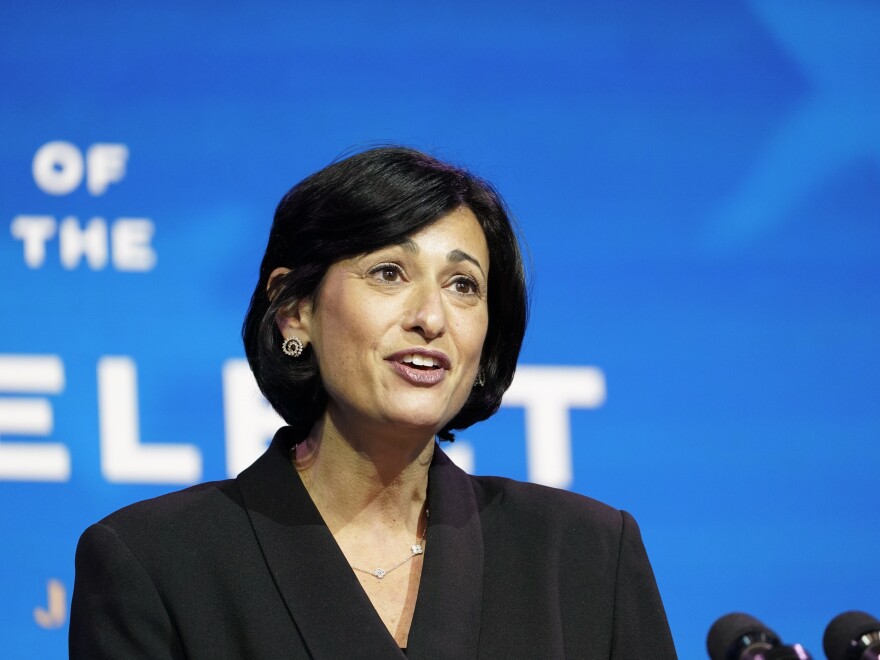The director of the Centers for Disease Control and Prevention voiced concern on Wednesday about the recent climb in the number of new cases of the coronavirus, warning that pandemic fatigue and the loosening of restrictions may be setting the stage for yet another surge this spring.
In an interview with NPR's All Things Considered, Dr. Rochelle Walensky said the next few weeks could prove pivotal in determining whether nearly one year into the pandemic, the United States will finally be able to find its way out of the crisis. But she said the nation is facing headwinds from both the spread of highly transmissible variants of the virus, and efforts to roll back guidelines around everything from mask use to how quickly businesses can reopen.
"I think the next two or three months could go in one of two directions," Walensky told host Ari Shapiro. "If things open up, if we're not really cautious, we could end up with a post-spring break surge the way we saw a post-Christmas surge. We could see much more disease. We could see much more death."
"In an alternative vision," Walensky continued, "I see we really hunker down for a couple of more months, we get so many people vaccinated and we get to a really great place by summer."
Walensky's comments followed announcements on Tuesday by the governors of Texas and Mississippi that they would be ending mask mandates in their states and allowing businesses to reopen at full capacity — decisions that President Biden likened to "Neanderthal thinking" on Wednesday.
In Texas, new cases are down about 9% from the average two weeks ago, but up 20% since last week. In Mississippi, new cases are similarly down from two weeks ago but up 62% over last week's numbers.
"The CDC squarely recommends routine masking, routine social distancing right now, right as we're at this nexus, this critical time, this tenuous point. So it squarely does not fit within the guidance that we are recommending," said Walensky,referring to Tuesday's announcements.
"I will say, though, that the reason that I mask is not because my governor tells me so," she added. "The reason I mask is because I know it protects myself, it protects my loved ones, it protects my neighbors and my community, so I think everybody is empowered to do the right thing and to put the mask on."
While the rollbacks in Texas and Mississippi represent two of the most expansive in the nation, they are far from the only ones to be announced. Massachusetts has allowed restaurants to reopen at full capacity, and in South Carolina, Gov. Henry McMaster has lifted prohibitions on large gatherings.
Walensky acknowledged the reality of pandemic fatigue. "We are all exhausted," she said.
But now, as more and more Americans are getting vaccinated, "there is a vision, there is a light at the end of the tunnel," she said.
"Now is not the time to stop to stop wearing a mask."
Since taking office in January, Walensky had mostly been looking at hopeful signs in the fight against the pandemic. Overall, new infections have fallen by roughly 70%, bringing the average number of new cases near levels last seen in the fall. Meanwhile, the number of new people hospitalized for COVID-19 has plunged by about 60% since the January peak.
But on Wednesday the CDC director warned that the agency continues to see "troubling signs" that recent progress has stalled. Speaking at a White House briefing, Walensky said the most recent seven-day average of new cases stands at 66,000, an increase of 3.5% over the previous seven days. Deaths were up 2.2% during that period to slightly more than 2,000 each day.
Officials have attributed the uptick to variants of the virus that are beginning to spread more widely and more rapidly throughout the country — particular the B.1.1.7 variant, which was first detected in the U.K and has been found to be 50% more transmissible than the strain that has been circulating in the United States.
"What worries me the most is that we're really stabilizing now, teetering at around 60,000 to 70,000 cases a day, and that is too many cases to try and put an end to this pandemic," Walensky told NPR.
"It also worries me because as we're sort of stabilizing with these very high levels of virus, we have this hyper-transmissible strain, the B.1.1.7 strain, that really threatens the progress that we've been making to date," she said. "And so, with these levels of virus circulating and this hyper-transmissible strain, I'm just worried about what the future looks like."
Walensky said it was too early to tell whether the country was hitting a plateau of cases or entering into a more prolonged upswing in cases.
On the vaccine front, Walensky expressed optimism when asked about President Biden's forecast this week that by the end of May, there would be enough vaccine supply for every adult in the U.S. That effort was given a boost over the weekend by the Food and Drug Administration's decision to grant emergency use authorization to a vaccine from Johnson & Johnson, making it the third vaccine to secure that authorization.
"I think the supply is going to increase more and more in the weeks ahead. I think end of March looks better, end of April looks even better than that," Walensky said. "So I think really we're talking in the four to eight week range where we're really going to start seeing a real step-up of supply."
Copyright 2021 NPR. To see more, visit https://www.npr.org. 9(MDAyNDY5ODMwMDEyMjg3NjMzMTE1ZjE2MA001))





